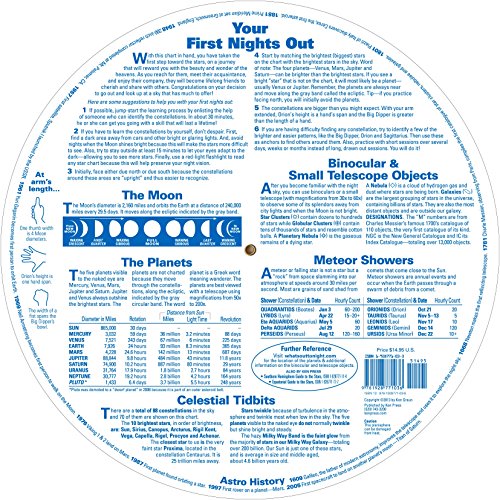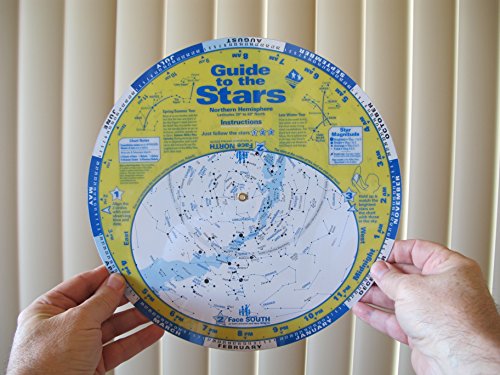Welcome to our blog post, “Stars Guide Review: Your Ultimate Celestial Companion”. If you’ve ever found yourself captivated by the beauty and mysteries of the night sky, this guide is just for you. It delves into the fascinating world of stars, providing valuable insights and information to enhance your stargazing experience. Whether you’re a novice or a seasoned astronomer, this comprehensive review will act as your go-to companion, unlocking the secrets of the universe and bringing the cosmos closer to your fingertips. So, grab a telescope and let’s embark on a celestial journey together.
Stars Guide
The Guide to the Stars is the perfect companion for stargazers of all levels. With its 11-inch diameter and durable plastic material, it offers a handy ”map” to help you effortlessly identify constellations in the night sky. The 4th edition of this incredible chart has taken stargazing to a whole new level of convenience and accuracy.
Using the Guide to the Stars is a breeze. All you need to do is dial-in your observing time and date on the chart to reveal the specific set of constellations visible in your sky. This ingenious feature is made possible by the clear top of the chart, which can be easily rotated to match your viewing conditions. It means that whether you are a beginner or an experienced astronomer, this chart will accurately guide you to the constellations above you.
The Guide to the Stars is not only incredibly functional but also visually appealing. The vivid and detailed illustrations of the constellations are beautifully depicted, adding an aesthetic touch to your stargazing experience. Whether you’re stargazing from your backyard or camping in the wilderness, this chart is the ultimate tool to enhance your astronomical journey. Don’t miss out on this 4th edition of the Guide to the Stars, where astronomy and convenience merge into one incredible product.
Review of “Guide to the Stars”
I recently purchased the 4th edition of the “Guide to the Stars” and I have been absolutely delighted with its performance. This compact and highly informative tool has become an essential companion for my stargazing adventures. With an 11-inch diameter, it strikes the perfect balance between portability and visibility.
One of the standout features of the “Guide to the Stars” is its use of a plastic material, which makes it lightweight and durable. I can confidently take it on my outdoor expeditions without worrying about it getting damaged. The clear top allows for easy rotation, enabling me to identify constellations with ease.
What truly sets this guide apart is its ability to dial in the observing time and date. This feature proves to be invaluable as it allows me to accurately locate and identify the stars and constellations that are visible at that specific moment. I no longer have to rely on guesswork or try to recall the positions of different stars in my memory. This saves me a lot of time and enhances my overall stargazing experience.
The “Guide to the Stars” excels in its comprehensive identification of constellations. The clear and detailed illustrations make it easy to identify and track various star patterns in the night sky. Whether you are a beginner or an experienced astronomer, this guide provides useful information that aids in understanding the celestial objects that surround us.
Furthermore, the guide’s size and compactness allow for easy storage and transportation. I can simply slip it into my backpack or stargazing kit without it taking up much space. This makes it the ideal tool for those who love to explore different locations to observe the stars. Its user-friendly design and straightforward layout make it accessible for individuals of all ages and skill levels.
In conclusion, the “Guide to the Stars” in its 4th edition is an excellent tool for any astronomy enthusiast. Its 11-inch diameter, plastic material, dial-in observing time and date, and clear top for rotation make it a versatile and reliable companion for stargazing adventures. Whether you are a beginner or an experienced astronomer, this guide is a must-have for identifying and understanding the beauty of the night sky.
Exploring Alternative Products for Stellar Guidance
I Achieved Champion League in Clash of Clans CWL with 77 Attacks using 11 Accounts this Season
Factors to Consider When Choosing a Telescope
When selecting a telescope, there are a few factors to consider. Firstly, think about your purpose for buying a telescope. Are you interested in stargazing or observing celestial objects in detail? This will determine the aperture size you need. A larger aperture allows for more light gathering and better views. Next, consider the telescope’s focal length, as this affects the magnification power. A longer focal length provides higher magnification, while a shorter one offers a wider field of view. Additionally, check the telescope’s mount. There are two common types: altitude-azimuth (up-down, left-right movement) and equatorial (following celestial objects). Decide which would be more suitable for your needs and preferences. Finally, set a budget and research reputable brands/models within that range. Reading reviews and seeking advice from experienced astronomers can help in making an informed decision.
- Accuracy: Check the accuracy of the guide in terms of star positions, constellations, and celestial objects. Look for reviews or recommendations from astronomers or experienced stargazers
- Level of Detail: Determine the level of detail provided in the guide. Consider if you want a beginner-friendly guide or if you prefer a more advanced one catering to experienced stargazers
- User-Friendly Layout: Examine the layout of the guide. Ensure it is organized logically, with clear maps, charts, or diagrams that are easy to understand and navigate
- Astronomical Events: Look for a guide that includes information about special astronomical events, such as meteor showers, eclipses, or transits. This allows you to plan your stargazing activities accordingly
- Observational Tips: Check if the guide offers practical tips and techniques for observation, such as suggestions on optimal viewing times, equipment needed, or interesting phenomena to explore
- Interactive Features: Consider if you prefer a digital version of the guide with interactive features, such as augmented reality or mobile apps, that can enhance your stargazing experience
- Portable and Durable: If you plan to bring the guide with you during stargazing outings, ensure it is portable and designed to withstand outdoor conditions. Look for durable materials or consider digital options for easy access on your devices
- Astronomical Information: Evaluate if the guide provides additional information about stars, galaxies, or other celestial objects beyond their basic identification. This could include details about their characteristics, history, or scientific significance
- Updated Editions: Check whether the guide is the most recent edition available. Astronomy knowledge and discoveries evolve, so having the latest information will ensure accuracy and relevance
- Recommendations and Reviews: Read reviews or seek recommendations from other stargazers, amateur astronomers, or experts in the field. Their insights can help you find a respected and reliable stars guide
Warning Signs that the “Stars Guide” Product Might Not be for You.
Frequently Asked Questions about Telescopes
What are the essential features or specifications to consider before buying a telescope for amateur stargazing or professional astronomy?
When buying a telescope for amateur stargazing or professional astronomy, there are several essential features and specifications to consider. These include:
- Aperture Size: The aperture, which is the diameter of the main lens or mirror, determines the telescope’s light-gathering capability. A larger aperture allows more light to enter the scope, resulting in brighter and clearer images. For stargazing and astronomy, a larger aperture is generally recommended.
- Focal Length: The focal length determines the magnification power of the telescope. A longer focal length will provide higher magnification, while a shorter one offers a wider field of view. The choice depends on the intended use and the objects you want to observe.
- Mount Type: Telescopes come with various mount types, such as equatorial and alt-azimuth mounts. Equatorial mounts are more suited for astronomy, as they facilitate tracking celestial objects. Alt-azimuth mounts, on the other hand, are more straightforward to use and better for casual stargazing.
- Optical Design: Telescopes come in different optical designs, including refractor, reflector, and compound (catadioptric). Each design has its pros and cons. Refractors are low maintenance and excel at viewing planets, while reflectors gather more light and are good for deep-sky observation. Compound telescopes combine the benefits of both types.
- Portability: Consider the telescope’s size, weight, and ease of assembly if you plan to move it frequently. Portable telescopes are more convenient for stargazing sessions away from light pollution.
- Accessories: Look for additional features like a sturdy tripod, eyepieces of varying focal lengths for different magnifications, finderscope for locating objects, and a star diagonal to enable comfortable viewing.
Ready to explore the wonders of the night sky? Discover the captivating world above us with our “Guide to the Stars”. Uncover the secrets of constellations, learn about planetary movements, and indulge in the beauty of celestial phenomena. Delve into the vast universe and spark your curiosity today.









